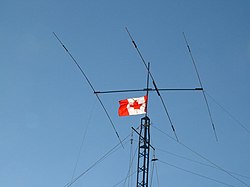
Back صيغة لارمور Arabic Fórmula de Larmor Catalan Larmor-Formel German Fórmula de Larmor Spanish Formule de Larmor French Equazione di Larmor Italian ラーモアの公式 Japanese 라모 공식 Korean Larmors formel NB Wzór Larmora Polish

In electrodynamics, the Larmor formula is used to calculate the total power radiated by a nonrelativistic point charge as it accelerates. It was first derived by J. J. Larmor in 1897,[1] in the context of the wave theory of light.
When any charged particle (such as an electron, a proton, or an ion) accelerates, energy is radiated in the form of electromagnetic waves. For a particle whose velocity is small relative to the speed of light (i.e., nonrelativistic), the total power that the particle radiates (when considered as a point charge) can be calculated by the Larmor formula: where or is the proper acceleration, is the charge, and is the speed of light.[2] A relativistic generalization is given by the Liénard–Wiechert potentials.
In either unit system, the power radiated by a single electron can be expressed in terms of the classical electron radius and electron mass as:
One implication is that an electron orbiting around a nucleus, as in the Bohr model, should lose energy, fall to the nucleus and the atom should collapse. This puzzle was not solved until quantum theory was introduced.
- ^ Larmor, J (1897). "LXIII.On the theory of the magnetic influence on spectra; and on the radiation from moving ions". Philosophical Magazine. 5. 44 (271): 503–512. doi:10.1080/14786449708621095. Formula is mentioned in the text on the last page.
- ^ Lorentz, Hendrik Antoon (1909). The theory of electrons and its applications to the phenomena of light and radiant heat. Leipzig: B.G. Teubner. pp. 49–52.






